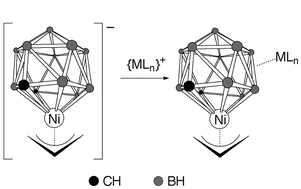Supraicosahedral and icosahedral nickelacarbaboranes bearing exopolyhedral metal fragments
Abstract
Treatment of the isomeric 12-vertex nickelacarbaborane salts [NEt4][3-(η3-C3H5)-closo-3,1,2-NiC2B9H11] and [NEt4][2-(η3-C3H5)-closo-2,1,7-NiC2B9H11] with [CuCl(PPh3)]4 and Tl[PF6] affords the zwitterionic bimetallic species [3-(η3-C3H5)-3,4,8-{Cu(PPh3)}-4,8-(μ-H)2-closo-3,1,2-NiC2B9H9] and [2-(η3-C3H5)-2,6,11-{Cu(PPh3)}-6,11-(μ-H)2-closo-2,1,7-NiC2B9H9], respectively. Similarly, the 13-vertex nickelacarbaborane [NEt4][4-(η3-C3H5)-closo-4,1,6-NiC2B10H12] reacts with sources of mono-cationic metal fragments to form [4-(η3-C3H5)-7,8,13-{Cu(PPh3)}-7,8,13-(μ-H)3-4,1,6-closo-NiC2B10H9], [4-(η3-C3H5)-3,8-{Rh(PPh3)2}-3,8-(μ-H)2-4,1,6-closo-NiC2B10H10] and [4-(η3-C3H5)-3,7,8-{RuCl(PPh3)2}-3,7,8-(μ-H)3-4,1,6-closo-NiC2B10H9]. The molecular structures of these five new bimetallic compounds were determined by X-ray diffraction studies, confirming that exopolyhedral Cu, Rh and Ru fragments are attached to the cluster via B–H⇀M agostic-type interactions and, in the case of the {NiC2B9} species, by a metal–metal bond.


 Please wait while we load your content...
Please wait while we load your content...